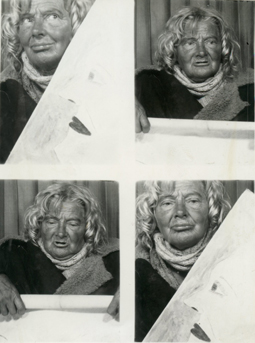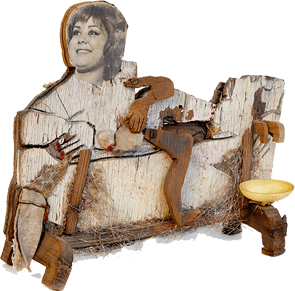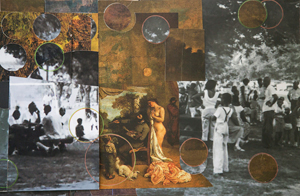Photography's Room for One
John Haberin New York City
Photo Brut and Gary Burnley
Can there be a more lonely place than a Greyhound station at night? And can there be a more intimate space than a room for one alone—a room for photos that no one else may ever see? Lee Godie made a habit of both. Godie went from bus station to bus station and from photo booth to photo booth, day and night, as people unseen caught their desperate sleep or hurried past.
One might mistake her subject for a man posing as a female blond, but it is just a close-up of her own round face and squat features. Only the sheer weirdness of her photos rescues them from banality. Not everyone in "Photo Brut" at the American Folk Art Museum relies on so primitive a camera, but it all lies in that strange space between private compulsion and public display. Does her obsession make Godie an artist or a nut case?  Maybe both, and the show of photographs as Art Brut can only bring out the slippery notions of photography and outsider art. As a postscript, Gary Burnley looks to art history in Europe for portrait photos of black America.
Maybe both, and the show of photographs as Art Brut can only bring out the slippery notions of photography and outsider art. As a postscript, Gary Burnley looks to art history in Europe for portrait photos of black America.
Intimacy and theater
Outsider art can be as wild and crazy as a city of countless eyes for Domenico Zindato or a "city of sociopaths" for Jeffrey Beebe. It can be as sophisticated as a biological specimen from Eugen Gabritschevsky or a drip painting by Janet Sobel. It can be as close to folk tradition as Mary Lee Bendolph and Gee's Bend quilting—or as close to the art of museums as Jean Dubuffet and Art Brut in America and France. These are strange choices, but how else to explain both its outsider status and its mainstream appeal today? Lee Godie and her haircut were anything but fashionable, but outsider art is now quite the fashion. Can it, though, be photography?
If all it took to make outsider art was a found image or a self-taught photographer, then Instagram would be the largest outsider art fair ever. Not everything, though, finds its way into social media. Bruno Decharme, a collector dedicated to Art Brut, has his own obsessive compulsion. He seeks out anonymous artists along with the big names of folk art. He turns up stashes in envelopes of unprinted negatives and unpublished work. Morton Bartlett, known for his doll portraits, left behind a crate of scattered limbs.
As curators, Decharme and the museum's Valérie Rousseau do their best to make sense of it all, even without space for AFAM's permanent collection—but how can things not get out of hand? "Photo Brut" (where I drop the full capital letters to reduce the shouting) contains four hundred works by forty artists. They supplement Decharme's collection with the museum's. Unprinted work appears in digital slideshows. Prints come from box cameras, but also such ungainly media as Polaroids and those photo booths. Like Ray Johnson, Elisabeth van Vyve preferred disposable cameras for whatever lay at hand, from clothing to dessert, and the result can be almost as disposable.
Not everything is so obviously a photograph. Kazuo Handa fashioned countless pipes, wrapped in slivers of magazine clippings and, well, smoking. Some artists merely embed a print in their manic drawing, like Jesuys Crystiano with his forest scenes, and Zdenek Košek appears to ditch the medium entirely for his psychotic visions. Others hand tint their photos, a tradition going back to the nineteenth century. Steve Ashby pastes portraits onto plywood figures, while Leopold Strobl and Pietro Ghizzardi paint over their photographs. A rural street for Strobl becomes grounds for a haunting—and an empty highway an extraterrestrial landing site.
The contributors come from every continent but Antarctica and from half a century ago to today. Their obsessions are no easier to pin down. The show divides into four sections, but wall text for each falls within the section, and who knows just where they begin and end? Walla and Salminen have plenty in common, but the first appears in "Performing," the second in either "Conjuring the Real" or "Reformatting the World." (I hesitate to say.) As with Godie, though, the greatest confusion of all lies between "Performing" and "Private Affairs."
Are they truly public or private? First to the left as one enters, with "Performing," Tomasz Machcinski gives his sitter the cocked hat and mustache of a Romantic bandit or hero. To the right, with "Private Affairs," Eugene Von Bruenchenhein photographs his wife as a pinup girl. Also to the left, someone went by the name Zorro, but the mark of Zorro on his models amounts only to short pants and leather boots. Also to the right, Marian Henel thrust his butt again and again at the camera. In pushing the bounds of propriety, intimacy becomes theater.
Diversity and madness
What, then, holds "Photo Brut" together? Nothing less than everything that threatens to tear it apart. It extends art photography to any means necessary. "Conjuring the Real" includes individuals and secret societies in search of UFOs, spoon bending, furry spirits, and "cold rays." They had, shall we say, a lot of technical assistance. Walker Evans and Ray Johnson turned to a photo booth decades ago, but not this.
 Then, too, it extends Art Brut, the French movement, to a global sensibility. Diversity is now a gallery and museum imperative, but it is startling all the same to see Machcinski in Poland followed by Ichiwo Sugino in Japan playing all the parts himself. For all the unknowns, the show also makes a case for the knowns of outsider art as photographers. Von Bruenchenhein had his family photos along with his frantic drawings and paintings, and Bartlett really was not just a doll maker. Henry Darger drew on children's books for his Vivian girls—scanning, enlarging, and tracing the images. If they are still drawings and paintings, so be it.
Then, too, it extends Art Brut, the French movement, to a global sensibility. Diversity is now a gallery and museum imperative, but it is startling all the same to see Machcinski in Poland followed by Ichiwo Sugino in Japan playing all the parts himself. For all the unknowns, the show also makes a case for the knowns of outsider art as photographers. Von Bruenchenhein had his family photos along with his frantic drawings and paintings, and Bartlett really was not just a doll maker. Henry Darger drew on children's books for his Vivian girls—scanning, enlarging, and tracing the images. If they are still drawings and paintings, so be it.
If anything, they share their compulsive personalities. Albert Moser assembles dozens of snapshots into the panorama of a New Jersey boardwalk. August Walla, Ilmari Salminen, and Valentin Simankov overwhelm photographs with their cryptic symbols. Miroslav Tichý hid his camera in his pants, pulling it out for shots of women he passed on the street. The sudden motion produced a blur out of film noir and a sense of danger out of Psycho, and so did Type 42's screen captures. Cindy Sherman and her Untitled Film Stills would fit here just fine.
Just as often, compulsion veers into madness. Machcinski knew madness at first hand when his mother killed his father, leaving him a child of the streets. A psychiatric hospital hardly knew what to expect when it allowed Henel a camera. Did Elke Tangeten embroider the outlines of a photographic portrait? Luboš Plný literally sews himself. The show has the brute insight to set them side by side.
In what may often seem an utterly chaotic layout, the chaos itself reflects their madness. Here private affairs are indistinguishable from public performance—and gender depends on both. And that, too, goes back to the early history of photography, like the theatrical poses of Alice Liddell for Lewis Carroll and Alice Austen for herself. Only here gender needs to be manufactured every day. Marcel Bascoulard dresses as dozens of women and Mark Hogancamp cross-dresses others as well. On the macho side of the equation, Alexander Lobanov poses himself armed to the teeth.
Is it all, then, a pose? Henry Darger could hardly be guilty of posing, between his sources in children's books and in his imagination. When he paints over an image of four ever so sweet children, he both enhances it and consigns it to memory—and yet it is still a form of theater, in which nothing comes naturally. And then there is Lee Godie posing as herself. She wanted herself on her worst day to be inescapable, and she wanted the evidence of a cheap and dirty photograph to be just as hard to overlook. For each artist, their love shines through, in what a due and proper history of photography would just as soon forget.
The likes of him
The Paris World's Fair had room for seemingly everything, but not for Gustave Courbet. Gary Burnley must sympathize, for not even Courbet had room for the likes of him. Burnley reproduces Courbet's L'Atelier du Peintre, or "painter's studio"—a "real" or "true allegory," its title continues, "defining" or "determining a seven-year phase of my artistic life." Not that Burnley can resist adding characters and layers to the French artist's cavernous and murky interior,  with the painter himself at his easel. Burnley's exhibition is all about exclusions and inclusions, in art history and the present. As an African American, he is out to redefine both, but even so he must speak "In the Language of My Captors."
with the painter himself at his easel. Burnley's exhibition is all about exclusions and inclusions, in art history and the present. As an African American, he is out to redefine both, but even so he must speak "In the Language of My Captors."
His photocollage could serve as a vital reclamation or a bitter joke. Figures in eighteenth- and nineteenth-century paintings appear in blackface, with faces out of other paintings as their disguise. Skin-tight masks may stop at a nose, like a mask for Covid-19, leaving it to you to piece together the races of the mouth and eyes. One black face appears in profile over a frontal portrait, but pruned back to the shape of a magnifying glass and with a huge circular gap for its eye. Burnley turns a black lens on white history, but well aware that black faces in old paintings meant something exotic out of Africa or the Americas. That leaves open who has the last word.
On a first viewing I could see only the formula, of black on white. It seemed to skate over past and present, with a heavy dose at once of pride and anger. Burnley, though, is happy to speak in tongues. He shakes things up with a mix of great and academic painters, whom he challenges one to pick out. He shakes things up, too, with faces from his own past. He includes a yearbook photo from grade school, with boys in formal wear and girls in pink, and a dapper self-portrait in black and white.
I should have spent more time with Courbet. Paintings covered every inch of the Palais des Beaux Arts in 1855, from floor to ceiling, but not his. "At all costs," he lamented, "a stop has to be put to my painting tendencies, which are disastrous for French art"—but he relished the unfolding disaster, which became the story of an emerging realism and Impressionism, and Burnley could only agree. This was eight years before the Salon des Refusés, where Edouard Manet caused a scandal with the nude and clothed picnic of Le Déjeuner sur l'Herbe. (Another African American, Mickalene Thomas, has taken that as a model for her "Glamour Project.") Already, though, Courbet had no compunction about opening a pavilion of his own, for some fifty paintings including the artist's studio.
His studio is a clumsy compilation much like Burnley's, though less deliberately and more shockingly. He threw in friends, including a collector and Charles Baudelaire, the poet and prophet of modern art. When he shows himself at work on a landscape, his back to a naked woman, Courbet could be acknowledging the source of his imagination—or rather turning away from the academy's privileged subject to stick to the observed. With her thick flesh, he claims a right to art as far back as Titian, a source for Manet as well. Then, too, he is rejecting the slim elegance in J. A. D. Ingres, who had set the tone for the acceptable. Burnley, too, will not be held captive.
Ingres puts in an appearance for him as well. Women dominate, because that is the language of the captor, but they gain in sympathy from their mix of styles and mixed race. Courbet's studio appears between gatherings of African Americans, while textured details in close-up approach abstraction. Overlaid circles appear often, like highlighting in a historian's archive or police investigation. Fears remain, but it is blacks who get to smile. As in a yearbook photo or a preposterous old painting, What Is Not to Like?

"Photo Brut" ran at the American Folk Art Museum through June 6, 2021, Gary Burnley at Elizabeth Houston through April 24.




